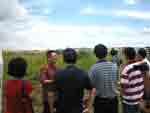Lesson 2
What is Qi?
Feng Shui is the Chinese Art of
capturing and using the Dragon's cosmic breath. The Chinese
called it Qi. The closest English translation of Qi is energy.
Qi is the core of Feng Shui and the whole point of Feng Shui.
The word “qi” in Chinese means
air, energy, spirit or luck. In Feng Shui, qi is a combination
of all these meanings, as Qi is more than just energy. In this
context, Qi refers to invisible energy that moves and
circulates across mountains and water, and it can bring
fortunes or misfortunes to man.
In Classical Feng Shui, we are
mainly concerned with where the qi is, what kind of Qi you
have in the area, how to bring the auspicious qi to the
property, and how to retain and distribute qi in the property.
This is what Feng Shui consultants mean when they talk about
“harnessing qi in the environment”.
When qi flows, the occupants of
a property are healthier, and perform better. When good qi is
blocked to reach a property, then the well-being of the
occupants will be affected, which could affect their health,
career and relationship.
Qi can be positive energy or negative energy. Positive energy
is termed as Sheng Qi, and the negative energy is termed as
Sha Qi. The following pages are the detail description of
Sheng Qi and Sha Qi
|
|
Sheng Qi
In Feng Shui, Sheng Qi means good, fortunate, and growth
energy. It is difficult to define sheng qi, but we can
understand sheng qi by the following illustrations:
-
When a man is full of “sheng qi”, he looks confident and
energetic.
-
When a house is full of “sheng qi”, it is clean, tidy,
full of laughter, joy, love, and has plenty of sunshine
and fresh air.
-
When a garden is full of “sheng qi”, the grass is
greener, the flowers is blooming, the breeze is
comforting, the sound of bird is soothing, and the water
is soothing.
-
When an office is full of “sheng qi”, the people are
cooperative, happy and diligently working.
-
When a restaurant is full of “sheng qi”, the restaurant
is serving delicious food, providing warm service,
customers are enjoying happily and satisfactorily.
Features producing Sheng Qi:
Good and beautiful looking objects produce sheng qi.
However, we have to determine the type of qi that the
object produces based on the shapes and colors, in order
to know whether the object is appropriately placed. Here,
Wu Xing is taken into consideration.
|
|
|
Sha Qi
Sha Qi is the opposite of
Sheng Qi. You can imagine the above illustration in a
negative way when the places are full of sha qi.
In Feng Shui, the common
sha qi producers are:
1)
Sharp pointing edges or corners
Any natural or man-made
structures that are sharp and pointing like sharp corners
of buildings, walls and mountains produce sha qi.
2)
Fast and strong wind, fast and strong water flow
Structures that create fast
strong wind or fast water flow produces sha qi. Examples
of sha qi producers are a long corridor or passageway with
high human traffic, convex side of a highway, and fast
moving river. When you face directly an incoming road with
heavy traffic, sha qi would affect you also.
Features producing Sha Qi:
Dirty and unpleasant
objects produces the evil energy, which is termed as sha
qi. Dirty home, cluttered home, dirty streets, polluted
cities, noisy places, rugged terrains, sharp pointing
edges, smelly environments produce sha qi.
Understanding Qi
Students of Master TY Tan were taken to site after class lecture to see and
feel Qi. With appropriate guidance, students'
understanding of Qi expanded and their practice of Feng
Shui become very much more effective.







|
|
Dear
Brothers & Sisters into the Dhamma,
I am
very lucky to have a very good lecturer of Feng Shui.
Absolute, from beginning until the end of class, I
followed and I was happy with Master explanation. I was
very happy with the Basic & Advanced Feng Shui course.
Thank you very much to our Master

Ven. Eh Sau Cha Cham, Thailand
Student of
Master TY Tan
|
